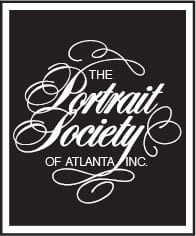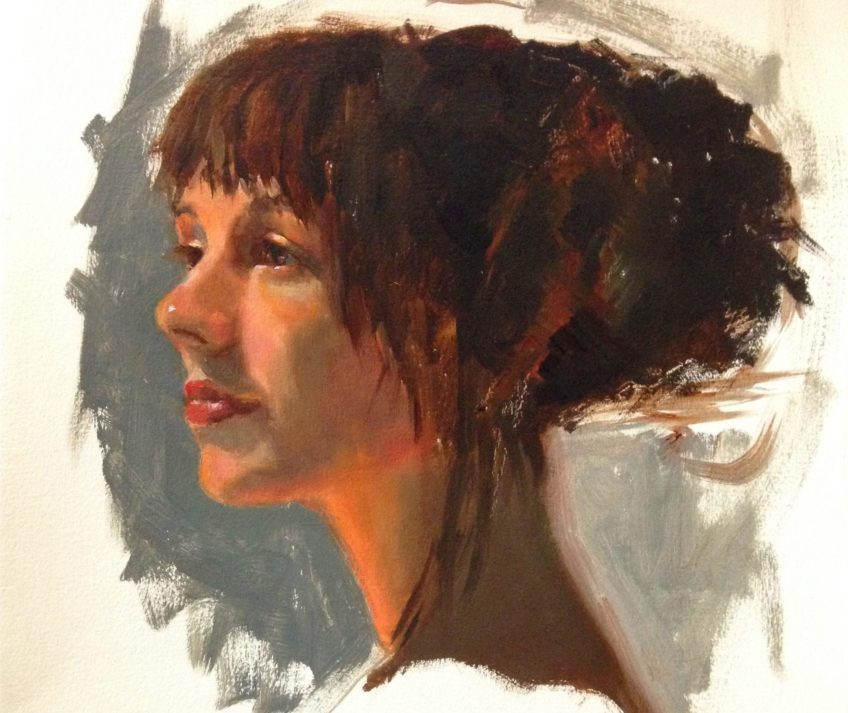by Ruby Mason
Have you ever studied a painting and asked yourself, “How did they do that?” What appears almost magical to the viewer is the result of trial and error, hard work, and of course, blood, sweat, and tears. Tuesday, May 23rd at the Portrait Society of Atlanta meeting, five award-winning PSA artists shared information about their favorite tools and methods.
 “I am not a portrait painter, I am a painter. I approach everything the same way. I paint shapes.” Focusing on value and not color, Kendall Portis (right) considers himself to be an abstract painter. “What can I simplify or take out?” he asks himself. He tries to reduce the subject to three or four dominant shapes and invites the viewer to bring something to the process. “If you draw
“I am not a portrait painter, I am a painter. I approach everything the same way. I paint shapes.” Focusing on value and not color, Kendall Portis (right) considers himself to be an abstract painter. “What can I simplify or take out?” he asks himself. He tries to reduce the subject to three or four dominant shapes and invites the viewer to bring something to the process. “If you draw  everything, the viewer doesn’t have a chance to speak to the painting.” Not wanting to over work the painting, he searches for the underlying abstract shapes and subtracts everything possible while still telling the story. He adds, “The viewer puts in the rest.” His procedure is to grasp these shapes quickly. For example, following this technique he strives to do a plein air landscape in about 30 minutes. As for his process and materials, Portis begins on a surface already toned to a mid-value, usually in either neutral green or blue. He prepares 140# watercolor paper with gesso and then tones the surface with the mid-value color using Benjamin Moore eggshell latex paint. To hone his abstract vision he does many gesture paintings of just five to fifteen minutes each, using gouache and large synthetic flat brushes to create strong, chiseled geometrical shapes. Trying to work quickly and broadly, he later stitches it all together with a little drawing. “I correct the shape until it says what I want it to say.” Reflecting on the brush strokes he noted, “all this is calligraphy, just beautiful mark making”. And quite dynamic mark making it is too.
everything, the viewer doesn’t have a chance to speak to the painting.” Not wanting to over work the painting, he searches for the underlying abstract shapes and subtracts everything possible while still telling the story. He adds, “The viewer puts in the rest.” His procedure is to grasp these shapes quickly. For example, following this technique he strives to do a plein air landscape in about 30 minutes. As for his process and materials, Portis begins on a surface already toned to a mid-value, usually in either neutral green or blue. He prepares 140# watercolor paper with gesso and then tones the surface with the mid-value color using Benjamin Moore eggshell latex paint. To hone his abstract vision he does many gesture paintings of just five to fifteen minutes each, using gouache and large synthetic flat brushes to create strong, chiseled geometrical shapes. Trying to work quickly and broadly, he later stitches it all together with a little drawing. “I correct the shape until it says what I want it to say.” Reflecting on the brush strokes he noted, “all this is calligraphy, just beautiful mark making”. And quite dynamic mark making it is too.
 As a compositional aid Paolo Chiezzi (right) demonstrated how he uses an Artograph projector to find the perfect composition. This is especially useful when combining elements from different photos into one large painting. His method is to use the projector to first size and position elements on the canvas, he then places landmarks to guide in the drawing. “I don’t use the projector to draw,” Chiezzi emphasized. He elaborated, “It is better to draw a good line in the wrong place, than a bad line in the
As a compositional aid Paolo Chiezzi (right) demonstrated how he uses an Artograph projector to find the perfect composition. This is especially useful when combining elements from different photos into one large painting. His method is to use the projector to first size and position elements on the canvas, he then places landmarks to guide in the drawing. “I don’t use the projector to draw,” Chiezzi emphasized. He elaborated, “It is better to draw a good line in the wrong place, than a bad line in the  right place”. Chiezzi described how he starts his paintings—“At the beginning I paint in monochrome”. He takes photographs of his drawing to use as reference. When painting indirectly, he prefers to let the cool undertones show through where appropriate. Known for his beautiful alla prima work, he completed his presentation advising that “Painting from photos will kill you, there is distortion in photos” and working alla prima from life will improve your ability in many ways.
right place”. Chiezzi described how he starts his paintings—“At the beginning I paint in monochrome”. He takes photographs of his drawing to use as reference. When painting indirectly, he prefers to let the cool undertones show through where appropriate. Known for his beautiful alla prima work, he completed his presentation advising that “Painting from photos will kill you, there is distortion in photos” and working alla prima from life will improve your ability in many ways.
Carol Baxter Kirby demonstrated the creative way she uses her iPad Pro. She simply attaches (with Velcro) her iPad to a T-square, which she then hangs on her canvas. This allows her to zoom in and work on a particular spot in the painting—a hand, for example—and view the reference at the same time, side-by-side. What a great idea!
Stating, “I like to incorporate a narrative into my paintings”, Tony Baselici (below, left) stood beside his impressive piece The White Widow (below, right). As a member of The International Guild of Realism, Tony paints with intricate detail and expresses, “I want the viewer to take their experience away with it.” For Baselici it is all about capturing the details, details define the person physically. He starts his work in a photo session with his subject and then paints from reference photographs. As he spends an average of more than 80 hours on a painting, working completely from life is not an option.
 Baselici shared several of his favorite tools, an unusual one being a pinstriping brush made of squirrel hair, a brush typically used for auto-detailing. There is something magical about this tool, he says. He uses this particular brush for fine details such as flyaway hair and strands in lace. Having trained as a scientific illustrator, there may be a correlation between that training and another favorite tool he loves to use, calipers. Everything is relative to everything else—you have to constantly check yourself, he advised. He elaborated, “Once I get a painting underway and something seems wrong, a lot of the time I’ll find that some relative distance is off”. He uses calipers for comparison between several sets of objects to resolve the problem. Baselici suggests not working in just one area, but to own the space. Busy working on a body of work with the goal of gallery representation, Tony delights in learning from every piece he paints.
Baselici shared several of his favorite tools, an unusual one being a pinstriping brush made of squirrel hair, a brush typically used for auto-detailing. There is something magical about this tool, he says. He uses this particular brush for fine details such as flyaway hair and strands in lace. Having trained as a scientific illustrator, there may be a correlation between that training and another favorite tool he loves to use, calipers. Everything is relative to everything else—you have to constantly check yourself, he advised. He elaborated, “Once I get a painting underway and something seems wrong, a lot of the time I’ll find that some relative distance is off”. He uses calipers for comparison between several sets of objects to resolve the problem. Baselici suggests not working in just one area, but to own the space. Busy working on a body of work with the goal of gallery representation, Tony delights in learning from every piece he paints.
In her journey, Margaret Ann Garrett once asked herself, “How do I get back into art”? Her answer was to go back to the basics and start again with drawing. Some of her suggested tools are toned paper, Nitram brand charcoal, vine charcoal, charcoal pencils, and white charcoal used sparingly for highlights. She finds wooden cigar boxes are a sturdy carrier for delicate charcoal. If a textured background is desired, she first applies clear gesso mixed with marble powder to the toned paper. From drawing practice, her indirect oil painting technique has evolved in a similar manner. She first draws in detail with a brush in thinned red oxide or umber and then underpaints in color.  The layers, which build in opacity, are allowed to dry between sessions (example right). Her palette is a mid-value toned turtlewood with colors on the perimeter, organized for efficiency. At each stage she takes photographs and studies the progress.
The layers, which build in opacity, are allowed to dry between sessions (example right). Her palette is a mid-value toned turtlewood with colors on the perimeter, organized for efficiency. At each stage she takes photographs and studies the progress.
There were many great questions from the audience, and while listening to these artists share what they’d learned, I was reminded of a song lyric “when you get where you’re going, turn right back around and help the next one in line”. A value—I’m thankful—that is shared by so many at the Portrait Society of Atlanta.


